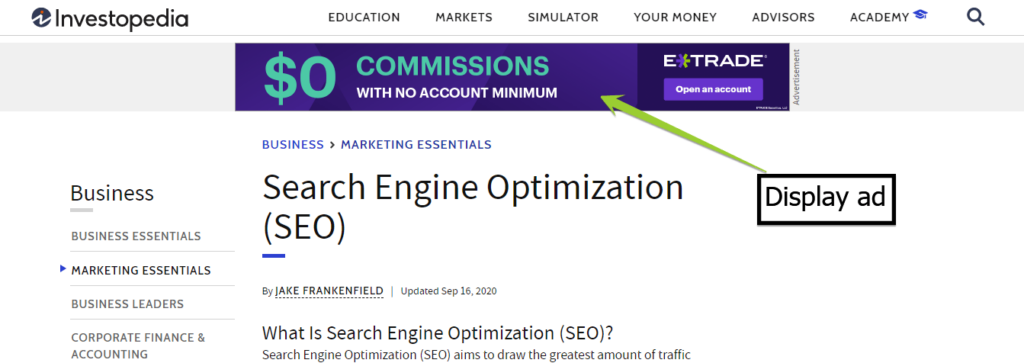-
 6 min. read
6 min. read
-
 Kevin Randolph
Kevin Randolph Content Writer
Content Writer
- Kevin is a Google Analytics-certified marketing specialist at WebFX, focusing on content marketing, SEO, and email marketing. He has a BA with a double major in mass communications and languages & cultures. When not writing and optimizing website content, Kevin enjoys playing bass guitar, hiking, and taking road trips.
The world of digital advertising is brimming with terminology, and new technologies and methods are arising all the time, leading to more new terms. It can be confusing to keep up with all this lingo, so in this post, we’ll look at two terms you’ve likely seen but might need some clarification on — programmatic ads and display ads. What do these two terms mean, what are the differences between them, and why should you use these types of online ads?
Find out in this post on programmatic vs. display ads:
- What Is The Difference Between Programmatic Ads And Display Ads?
- What Are Programmatic Ads?
- What Are Display Ads?
- Comparing Programmatic And Display Ads
- Advantages Of Programmatic Advertising
- Advantages Of Display Ads
What is the difference between programmatic ads and display ads?
The difference between programmatic ads and display ads is the purchase process. Programmatic advertising uses multiple ad exchanges while display advertising uses a single ad network, like Google Ads.
What are programmatic ads?
Programmatic ads are online ads that advertisers purchase and place using software as opposed to manual methods. Programmatic ad buying software allows advertisers to use automation to purchase ad space, choose ideal locations for ads, target their ads, and more.
This differs from the traditional methods of negotiating with human representatives and manually requesting individual ad placements.
What are display ads?
Display ads are visual-based digital ads. These ads may contain images, video, text, and audio and come in various formats, including banner ads, video ads, and native advertising. Advertisers can place display ads on websites through networks such as the Google Display Network.
The term display is often used to differentiate image and video-based ads from text-based ads on search engine results pages (SERPs). Display ads show as users browse various websites, while search ads appear after users search terms on search engines. Here’s an example of a display ad in the form of a banner ad: 
Comparing programmatic and display ads
The terms programmatic and display refer to two different aspects of digital advertising.
Programmatic refers to how ads are purchased and placed. Display refers to the format of the ad and where it appears — visual ads placed on a network of websites. Because programmatic and display refer to two different aspects of advertising, the two categories can overlap.
Some programmatic ads are display ads, and some display ads are programmatic. However, you can also place display ads manually rather than programmatically. You can programmatically purchase types of ads other than display ads, such as search ads.
Advantages of programmatic advertising
Programmatic advertising is likely the future of online advertising as it offers numerous advantages.
Here are six key benefits of programmatic advertising:
Efficiency
Programmatic advertising can save you significant amounts of time using automation. Automation can take care of repetitive tasks, such as placing bids and requesting ad space. It can also help you complete analyses that would otherwise be extremely time-consuming.
Precise targeting
Programmatic advertising gives you more options when it comes to ad targeting and makes it easier to use advanced targeting methods.
With programmatic advertising, you can target your ads based on:
- Demographics: Information such as age, gender, income, marital status, and more
- Interests: Preferences and interests based on information users provide and the websites they visit
- Location: From broad areas such as countries and regions to specific places like neighborhoods, specific addresses, and individual stores
- Retargeting: Targeting users who have previously visited your website or expressed interest in your products or services
Transparency
Automation and software provide advertisers with lots of information about where their ads get placed, how much they’re paying, and how their ads perform. This information allows for greater transparency into advertising campaigns.
Real-time reporting and optimization
Through advertising software, advertisers can get real-time reporting about how their ads are performing. You can see precise details about your ads’ performance and use this information to optimize your campaigns.
Increased reach
Automation allows advertisers to search a massive list of sites to determine the perfect placements for their ads.
Manually, advertisers couldn’t look through anywhere near as many websites. These capabilities give your ads increased reach, which can lead to improved results.
Improved ROI
Programmatic advertising can improve your ads’ performance through automation, precise targeting, reporting, and optimization. It can also save you time and money through automation, improving your return on investment (ROI).
Advantages of display ads
Display ad spending in the U.S. is expected to reach more than $92 billion in 2021. Why are advertisers investing so much in digital advertising? Because it’s effective! Here are a few of its benefits:
Visual appeal
Display ads can be eye-catching and visually appealing, helping to get users’ attention and create positive impressions of your brand.
You have a lot of creative freedom with display ads. For example, with banner advertising, you can use images, graphics, video, animation, and text and include your brand’s colors and logo.
Brand awareness
One of the best ways to use display ads is to increase brand awareness. Users will see your ads as they’re browsing various sites, introducing your brand to them.
The visual nature of display ads also allows you to convey important brand elements quickly.
Targeting benefits
Display ads are useful for many of the targeting options you get with programmatic advertising. You can use display ads to target leads who may be close to a purchase decision using retargeting. You can also show variations of your ads to users based on their demographics, location, or interests.
For example, if you run a pet store, you could show ads featuring cats to users who have cats and show dog owners ads with dogs in them.
Cost-effectiveness
Compared to other types of advertising, like television or billboards, you can get started with display advertising with a relatively small investment. You don’t have to invest much in producing the ads, and you can set your campaign budgets at whatever level you want.
Large reach
Reach depends largely on the ad network you use, but display ads can have an extensive reach, introducing your brand to new users who might otherwise never have found you. For example, one of the most popular networks, the Google Display Network, can show your ads across more than two million websites, apps, and videos and reaches more than 90% of global Internet users.
Get started with programmatic and display ads
Online advertising, including programmatic and display ads, is a huge part of digital marketing.
Digital ad spending now accounts for more than half of ad spending in the U.S. and for good reason — it gets results. According to Google, its ad network has an average ROI of $2 for every $1 spent.
One of the best ways to maximize the value you get from online advertising is to work with an experienced digital advertising company. At WebFX, we’ve managed more than 650 pay-per-click (PPC) advertising campaigns for our clients. We’re a Google Premier Partner, and we’ve generated more than $10 billion for our clients over the last five years.
To learn more about working with our team of more than 500 digital marketing experts, explore our PPC management services or request a free quote online today.
-
 Kevin is a Google Analytics-certified marketing specialist at WebFX, focusing on content marketing, SEO, and email marketing. He has a BA with a double major in mass communications and languages & cultures. When not writing and optimizing website content, Kevin enjoys playing bass guitar, hiking, and taking road trips.
Kevin is a Google Analytics-certified marketing specialist at WebFX, focusing on content marketing, SEO, and email marketing. He has a BA with a double major in mass communications and languages & cultures. When not writing and optimizing website content, Kevin enjoys playing bass guitar, hiking, and taking road trips. -

WebFX is a full-service marketing agency with 1,100+ client reviews and a 4.9-star rating on Clutch! Find out how our expert team and revenue-accelerating tech can drive results for you! Learn more
Try our free Marketing Calculator
Craft a tailored online marketing strategy! Utilize our free Internet marketing calculator for a custom plan based on your location, reach, timeframe, and budget.
Plan Your Marketing Budget

Proven Marketing Strategies

Proven Marketing Strategies
Try our free Marketing Calculator
Craft a tailored online marketing strategy! Utilize our free Internet marketing calculator for a custom plan based on your location, reach, timeframe, and budget.
Plan Your Marketing Budget
What to read next





